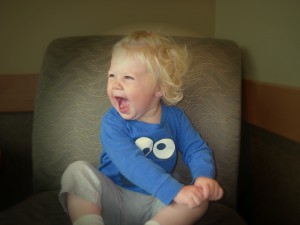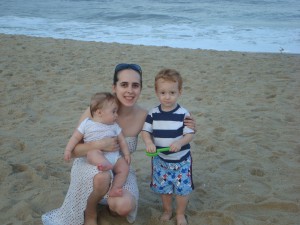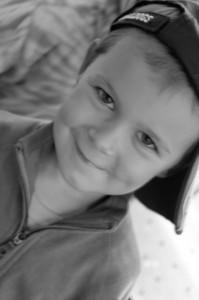This is Part 1 in a 5-part series of the most common kinds of challenges AP parents go through when our kids grow out of infancy and into toddlerhood.
 What do you find most challenging about transitioning from using AP in infancy to using AP in toddlerhood?
What do you find most challenging about transitioning from using AP in infancy to using AP in toddlerhood?
I asked this question on the API Facebook page, and the response was overwhelming! Hundreds of parents chimed in with their thoughts on what makes the transition from parenting an infant to parenting a toddler so challenging. Those moments when your little one exhibits a behavior for the first time, and it’s not the rolling over/ first steps/ first words kind of celebratory milestone. The moments of uniquely toddler behavior that make you pause and think, “Hmm, this is new … and not entirely pleasant. Now what should I do?”
Despite the variety of responses, there was consensus: the transition is, indeed, challenging. Here are your answers and a few tips to help you navigate this period in your child’s development.
Challenge: Discipline
- Trying to express gentle discipline while my toddler is having a hard time absorbing things.
- Discipline
- Toeing the line between honoring their feelings and disciplining.
- Discipline!
- Finding ways to discipline him. Now my youngest is picking up on his behavior.
Tip: Start with 3 basic positive discipline tools in your toolbox.
There are many types of positive discipline tools that help teach children behavior while preserving and maintaining an attached relationship. Lots of parents struggle with the transition into positive discipline as it can be overwhelming to know which tools to use and when. Is it the right moment for a time-out? A firm “NO”? Should I try spanking? Here are three essential parenting tools to add to your toolbox as a starting point for using positive discipline.
1. Prevention, prevention, prevention. A toddler’s brain is mature enough to take on new behaviors—exploring her environment and her newfound autonomy—yet is not mature enough to exercise any self-control over her actions. This means you must help with her self-control until her brain matures enough for her to take over. Stay close to your mobile toddler so you’re able to step in and prevent any inappropriate behaviors before they occur.
– Wandering away? Stay with her so you can take her hand or pick her up when necessary.
– Climbing on everything? Stay with him so you can either be a ready spotter as he climbs or ready to move him to a different area to play.
– In a hitting phase? Stay with her so you can tune into her frustration, stop her from hurting anyone and move her to a safe place.
– Exploring cabinets and household products? Stay with him to ensure he plays with appropriate items or toddler-proof the house with locks and safety latches.
2. Focus on solutions over punishment. Adopt a “working with” approach to your toddler’s behavior, rather than a “doing to” approach. Work with a toddler’s immature brain development and natural desire to explore by finding appropriate alternatives to inappropriate behavior. If your toddler has a tendency to run into the street, rather than punish him for something his brain is not mature enough to handle (the ability to stop, think, remember what you said and make a conscious decision to turn away), find a solution that meets everyone’s needs. Hold your child’s hand by the street or only play in the fenced backyard. If your toddler can’t sit still in a restaurant, go for walks while you wait. If your toddler likes to throw objects, put the dangerous objects out of reach and give her only those which are safe to throw.
3. Make time-outs positive. Inevitably, your toddler (and you!) will have moments of emotional overwhelm. Ensuring that you both get adequate sleep, healthful foods to eat and plenty of connected time together will help with that. But because of your toddler’s immature brain, there will be times when his feelings simply become too much for him to handle. The tantrums will come. The anger, frustration and sadness—as well as accompanying behaviors—will happen.
In these moments, focus on calming down, restoring your brain chemistry and feeling better before you do or say anything else. Time-outs are an effective positive discipline tool as long as they are implemented in a non-punitive way. “Making Time-out Positive” on TheAttachedFamily.com explains how to encourage positive time-outs in a comforting place. It is important that children understand that their feelings are normal and that mom and dad will help them feel better. So, add positive time-outs to your toolbox. Use them to model how you help yourself feel better so you can do better, and teach your child to do the same.
You’ll discover more helpful positive discipline tools as your child grows, but these three are a great place to start with young toddlers. They give you a strong start in handling most toddler behavior issues.
Challenge: Living in a society that doesn’t seem to value attachment.
- Watching our children, with their increasing awareness, interact with a non-AP world
- Dealing with the influence of peers as kids encounter social situations in which AP is “weird”
Tip: Remember that YOU are your kids’ primary attachment, and that is powerful.
No one else’s interactions carry as much influence as yours do. When your children encounter unkind behavior, hear violent language or witness anther parent’s harsh discipline, be there for them. They may question what they encounter outside of your family, but your attachment provides a foundation for growth that is stronger than you can imagine. Yes, you should answer their questions, respond to their inquiries and begin to explain the world in simple but straightforward terms. Let your toddlers’ real-world experiences guide your teaching. Just always remember that you don’t have to have the answers for them; you are their answer. Hold onto that as you navigate this “less-than-attachment-minded” world.
There’s more! Watch for Part 2 of this series highlighting more challenges and more tips in transitioning from AP in infancy to AP in toddlerhood.
 Hitting is a normal toddler behavior that often begins between ages 1 ½ and 2 years old. There could be many different reasons, including the child being angry but unable to express it or you being unable to understand what he’s trying to express, a life change such as a new sibling, or simply the child wanting to explore what her hand can do and what happens when she hits.
Hitting is a normal toddler behavior that often begins between ages 1 ½ and 2 years old. There could be many different reasons, including the child being angry but unable to express it or you being unable to understand what he’s trying to express, a life change such as a new sibling, or simply the child wanting to explore what her hand can do and what happens when she hits.

